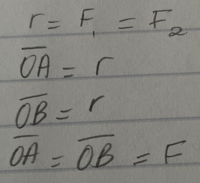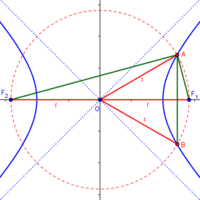johnnyluvsmath
New member
- Joined
- Jan 13, 2021
- Messages
- 17
We'll need to see what your starting point is, in order to help.I have this problem that I can’t solve, if someone could help me I would really appreciate it.
We'll need to see what your starting point is, in order to help.
What definitions are you using, and what theorems do you know about a hyperbola? Can you use the equation of the curve, or must you use geometrical facts directly?
That's one reason we ask to see your work:
Posting Guidelines (Summary)
Welcome to our tutoring boards! :) This page summarizes main points from our posting guidelines. As our name implies, we provide math help (primarily to students with homework). We do not generally post immediate answers or step-by-step solutions. We don't do your homework. We prefer to help...www.freemathhelp.com
Please show whatever you have tried, in addition to answering my questions, so we know what help you need.
That’s what I was able to do until now. I proved that Segment OB= segment OA. Now I have to prove that segment AB is the same length as the other two segments, but I am not quite sure how. Can you help me now?


Yes I am using geometrical methods and by f1=r I meant segment OF1=r I should’ve been more clear. I have learnt about the hyperbola equations, how to find the variables and how to graph them. Basically grade 11-12 level.View attachment 24342
That doesn't really make any sense; isn't r a number, while F1 and F2 are points?? And what is F?
You didn't answer my questions. It appears that you are using geometrical methods; but what definition are you using for the hyperbola?
What have you been taught about hyperbolas? That's your starting point, and I don't yet know what it is, so I can't help you get moving.
Here is my picture of what I think you've done (in red) and a few lines (in green) that you need to deal with. I see some interesting facts hidden in there ...
View attachment 24344
Please, please, answer my specific questions! I honestly don't know how to help you until you do. (I have no idea what your curriculum would cover, even if I knew where you are.)Yes I am using geometrical methods and by f1=r I meant segment OF1=r I should’ve been more clear. I have learnt about the hyperbola equations, how to find the variables and how to graph them. Basically grade 11-12 level.
I have learnt about the trigonometric circle (tan, sin, cos, cosec, cotant, sec), and my curriculum has covered all the functions by now and I have learnt how to manipulate the equations when they are in different forms. I have learnt that k=vertical translation h=horizontal translation a=vertical stretch b=horizontal stretch c=focal distance in simple and what happens when they are negative. it has also covered mixing multiple functions together to find an intersection with little clues. we’ve also covered vectors. I’ll attack a few pictures of the summaries of what I’ve learnt and one picture of a similar problem to give you an idea of how it is supposed to be done if it helps, i’m not very good at explaining.Please, please, answer my specific questions! I honestly don't know how to help you until you do. (I have no idea what your curriculum would cover, even if I knew where you are.)
If you are using geometrical methods, tell me the geometrical definition and properties you have learned. If you are using algebraic methods, then tell me the equations and the meaning of the variables as you were taught them. Or maybe you are really expected to use a mix of both. If I were helping you in person, I would long ago have grabbed your book from you and started looking through it for definitions, examples, and so on; but I have to depend on you. Please help me!
Also, we'd like to see some actual work, because our goal is to help you do it, not just give a solution. So whatever I end up giving you is going to be a first step or a hint for the overall process.
This is a very interesting problem that I very much want to do, but I can't start thinking about it until these questions are answered.
I'll add one thing. If in fact you are to use the equation of the hyperbola, then it's easy. Just write that equation and the equation of the circle, solve to find the intersections, and find the distance between them. (I've been assuming that's not how you're to do it.)
Thanks. You have learned the geometrical definition of the hyperbola (constant difference of distances to foci), but most of what you are doing is analytic geometry (equations), not geometrical proofs proper. So my suggestion at the end last time is all you need:I have learnt about the trigonometric circle (tan, sin, cos, cosec, cotant, sec), and my curriculum has covered all the functions by now and I have learnt how to manipulate the equations when they are in different forms. I have learnt that k=vertical translation h=horizontal translation a=vertical stretch b=horizontal stretch c=focal distance in simple and what happens when they are negative. it has also covered mixing multiple functions together to find an intersection with little clues. we’ve also covered vectors. I’ll attack a few pictures of the summaries of what I’ve learnt and one picture of a similar problem to give you an idea of how it is supposed to be done if it helps, i’m not very good at explaining.
I am expected to mix both algebraic and geometric methods because I have to prove that the triangle is equaleral without using any numbers, that is also why I have not yet tried to solve the intersection with the equations of the circle and hyperbola.
Because I am in the advanced courses,I pretty much have to use any possible way to prove that the triangle is equilateral because they don’t care how I do it. Also I don’t expect anyone to solve it. I have an exam in a few days and my average is very high up to now but I can’t solve the ones where you have to prove something without any numbers. I want to keep my average high so I need to figure it out myself so it sticks with me but I need some clues and some explanation. I’m sure there is something very simple about it that I am missing.
Just write that equation and the equation of the circle, solve to find the intersections, and find the distance between them.
Thank you so much!!!! it was a great help and I was able to solve the problem and prove triangle OAB is equilateral. my calculations might not be super clear but here they are.Thanks. You have learned the geometrical definition of the hyperbola (constant difference of distances to foci), but most of what you are doing is analytic geometry (equations), not geometrical proofs proper. So my suggestion at the end last time is all you need:
Since the asymptotes are perpendicular, how are a and b related? Then what is c? You will be able to express them all in terms of one of them, and you'll have the coordinates of the foci, too.
Now write the equations of the hyperbola and the circle, in terms of that one parameter (I used a); you'll have a system of equations that you can solve for x and y, which will tell you the coordinates of A and B. Then just use the distance formula (or something simpler) to find the length of AB, and you'll be done.
Give it a try, and show us your work.
Good, partly.Thank you so much!!!! it was a great help and I was able to solve the problem and prove triangle OAB is equilateral. my calculations might not be super clear but here they are.
I actually did that first but my x would cancel each time so I tried to solve it with the pythagorean theorem, which clearly didn’t make sense. I erased it and simply put x instead. I figured it wouldn’t be necessary to find the value of x since in the picture it’s clearly shown that point A and B have the same value of x.Good, partly.
Your y's are correct, and that's all that mattered for the proof; but your x can't possibly be right. The lower left corner is full of nonsense! To find x, just plug y into either equation and solve for x.
True. But go ahead and find the correct value of x; it will be good for you. If things still cancel out, show me your work so I can point out the error.I actually did that first but my x would cancel each time so I tried to solve it with the pythagorean theorem, which clearly didn’t make sense. I erased it and simply put x instead. I figured it wouldn’t be necessary to find the value of x since in the picture it’s clearly shown that point A and B have the same value of x.
it should make sense now I think. I just switched the signes from one of the equations so that the y would cancel out instead of the x.True. But go ahead and find the correct value of x; it will be good for you. If things still cancel out, show me your work so I can point out the error.
my bad I put a 5 instead of 6 at the end.it should make sense now I think. I just switched the signes from one of the equations so that the y would cancel out instead of the x.
Good work.my bad I put a 5 instead of 6 at the end.
